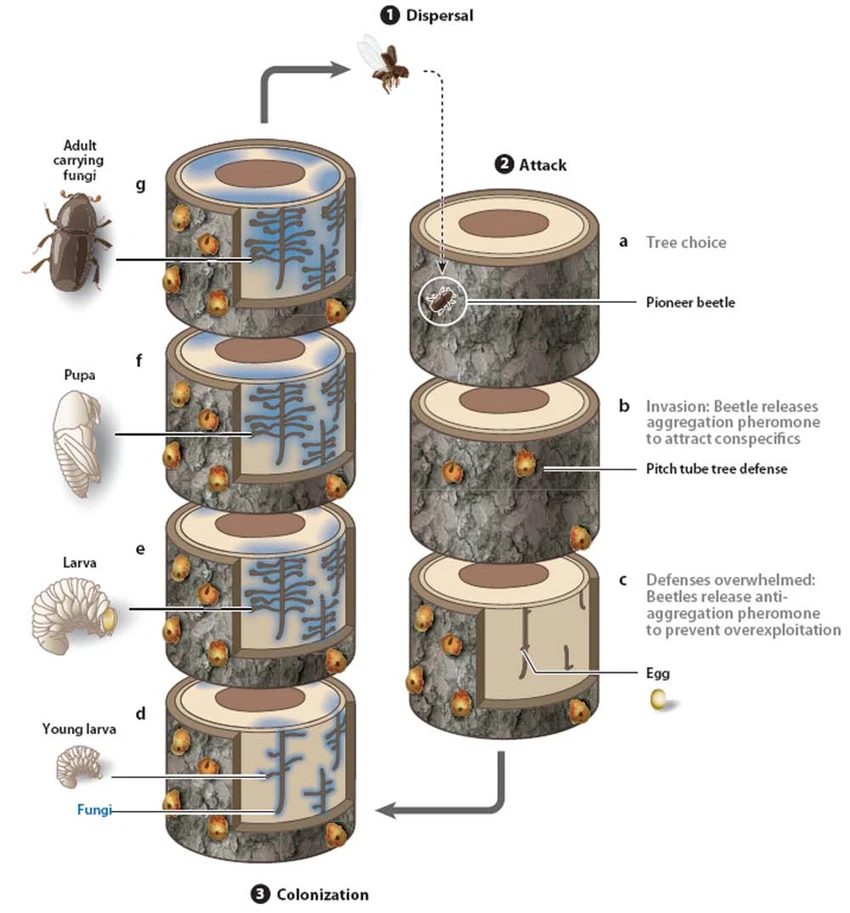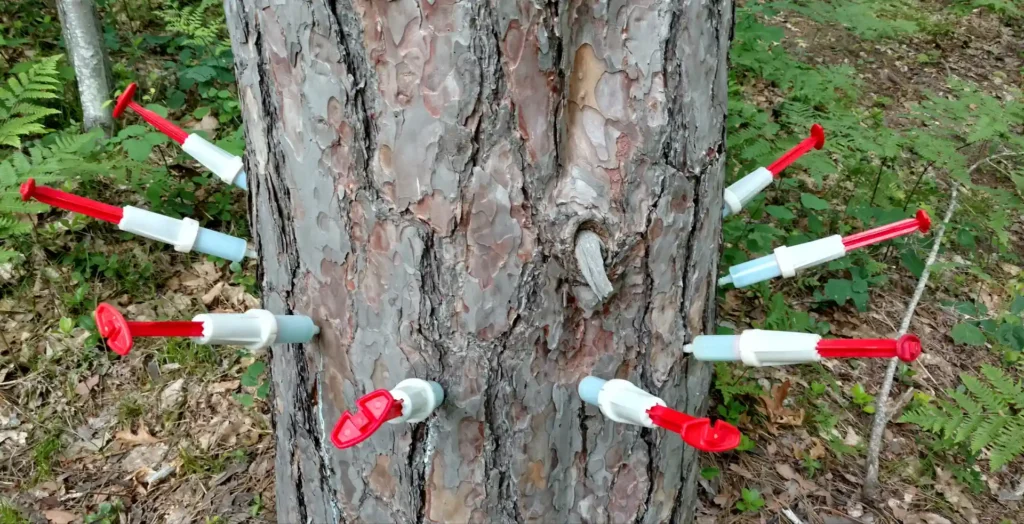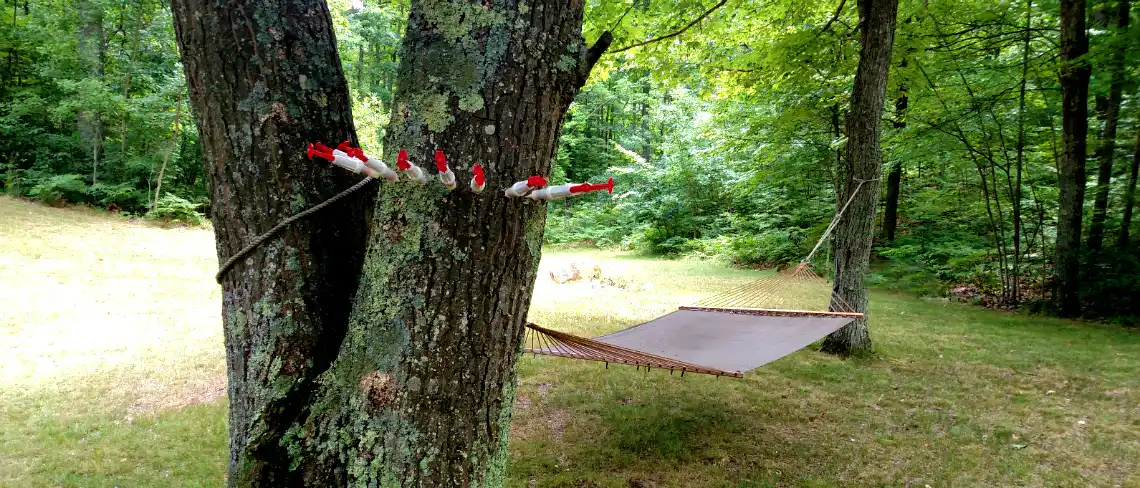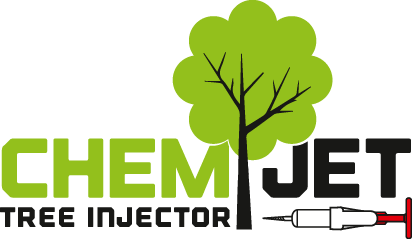Pine Bark Beetle Injection Treatment

Save Your Trees from Pine Bark Beetle and Spruce Beetle with DIY Tree Injection
Pine Bark Beetle Treatment and Prevention. Take action to protect your pine trees from Pine Bark Beetles with easy “do it yourself” tree injection.
There are a variety of bark beetles that infest conifers throughout North America. Adults beetles travel by flying to a new tree, tunnel through the bark, mate, and lay eggs in the inner bark. The larvae develop, feed on the inner bark causing damage to the tree and emerge by boring out through the bark. Larval feeding cuts grooves along the inner bark and interrupts the tree’s ability to move water and nutrients up and down within the afflicted tree.
Other Treatments and Info
- Oak Wilt Prevention and Treatment
- Save Your Trees from Oak Wilt
- Microinjection to Protect Trees From Oak Wilt
- Emerald Ash Borer Treatment
- Dutch Elm Disease
- Pine Bark Beetle Injection Treatment
- Sudden Oak Death
- Hemlock Woolly Adelgid Treatment
- Asian Longhorned Beetle Treatment
- Caterpillars, Beetles, Borers
- Orchard Crops Treatment
- Plugs for Tree Injection Holes
- Chemjet Tips and Ideas

Bark Beetles and Their Impact on Pine Trees
Several species of beetle also carry spores on their bodies to introduce the blue stain fungus which clogs up the vascular system of the tree and also inhibits the ability of the tree to move water and nutrients. Common species of Pine Bark Beetles include Southern Pine Beetle, Mountain Pine Beetle, Western Pine Beetle, Ips Engraver Beetles, and Spruce Beetles.
Bark beetles are very small, 3-4mm long with cylindrical brown bodies. They are hard see but infestation is easily identifiable by pitch tubes on the tree trunk which are holes in the tree with what appear to be popcorn stuck to them. These are masses of pitch resin which is a symptom of the tree trying to defend itself by producing a lot of pitch where the beetles bore holes through the bark. This defense will work for tree survival from a small number of attacking beetles. But very large numbers of attacking beetles overwhelm this defense. Also drought stressed trees are not able to produce enough of this resin when attacked. Another indication of bark beetle infestation is a significant amount of “sawdust” in bark crevices and on the ground at the base of the tree.
Chemical Treatment
- Pine Bark Beetle Injection Treatment
Direct injection of pesticides through the bark and into the trunk of conifers is an environmentally sound and economical way of treating for Pine Bark Beetles. Trunk injection is a systemic tree treatment which is very efficient and works quickly, with the pesticide circulation throughout the tree within a few days.
This can be easily conducted using Chemjet® Tree Injectors to inject pesticides such as injectable emamectin benzoate (like Tree-age G4 or TreeMec Inject) into small drilled holes at multiple locations around the circumference of the tree. There are specific directions for use of these chemicals on the product labels which should be strictly followed. Using Chemjet Tree injectors, a typical labeled injection rate of Tree-age G4 is 20 ml injected every 6 inches around the circumference of the trunk.
Following injection, the chemical is then carried by the vascular system throughout the tree, from up to the needles down to the roots, effectively killing or driving away pine bark beetles and larvae currently in the tree, and preventing future infestation by visiting beetles.

Injection Procedure for Pine Bark Beetle
This example injection procedure for pine bark beetle is adapted from the Chemjet® manufacturer suggested procedure, and from the Tree-age G4 label (follow labeled mixing and use instructions for the chemical that you choose to use). You can inject at the root flare just above the ground, or at some point up the trunk that is easier to reach. You don’t need to treat around the whole trunk at once. You can work your way around the tree over the course of a couple days with fewer Chemjets if you wish.
- Confirm with a qualified arborist or biologist that this procedure is appropriate for your tree. You may not have pine bark beetle risk or there may be other circumstances that would cause this procedure to be inappropriate. Also there may be a risk that this procedure may harm your tree.
- Only inject pine or spruce trees during the seasonal time period necessary to be effective for treatment.
- In southern states during hot weather it works best to inject trees after a good rain or after substantial watering.
- Plan for use of one Chemjet® Tree Injector every six inches around the circumference of the tree.
- Follow personal protection recommendations from the treatment chemical label. This would generally include wearing rubber gloves and safety goggles during all mixing, injection and cleanup work.
- Disinfect Chemjet® injector and drill bit by washing and scrubbing in diluted bleach solution or Lysol disinfectant solution. Pull disinfectant solution through the nozzle filling the injector several times. Rinse with clean water.
- Prepare the insecticide injections per the instructions on the label from the chemical you are using. From the Tree-age G4 label the maximum dose is just over 6-inch spacing around the circumference of the tree using Chemjet Tree Injectors filled with 20 ml of Tree-Age G4 Inject. Lesser doses and reduced spacing could be accomplished by diluting the chemical with water.
- Drill one hole at a time at 45 degree angle downward no more than 1.25 inch deep. Only use a 11/64 drill bit. Drilling more than one hole at a time may result in the tree filling up the holes with pine pitch before you have time to insert the Chemjet tree injectors.
- Pull the chemical mix from step 7 into the injector until full at 20 ml and lock the handle back while twisting.
- As soon as hole is drilled, insert the Chemjet loaded with treatment chemical. Push into place and seal (don’t twist because the nozzle may break off).
- Using both hands, hold the Chemjet® in place and then twist and release the red plunger so that injection begins. If there is leakage push the nozzle in harder to seal.
- After all chemical is in tree, pull injector straight out of hole. If chemical starts oozing back out of open hole, replace Chemjet® and leave there for another half hour or use a plug.
- Repeat for the remaining holes going around the tree at the prescribed spacing.
- If an injector is taking chemical slowly, leave it in place and move on. It could take up to 24 hours.
- IMPORTANT: Disinfect drill bit and all Chemjets (inside and out) before using on any other tree per step 6. Disinfect your hands and put on new rubber gloves to avoid potential for transferring diseases to next tree.
- Take Care of your Chemjet Tree Injectors after the work is done (or during long term work at least once per week) so they keep working smoothly by disassembling, washing all parts with hot soapy water, rinse and air dry, then lubricate the nozzle barrel and rubber plunger washer with silicone lube or vegetable oil before reassembly.
Practical Implementation Considerations
Because of the relative cost and effort involved in conducting systemic tree injections, it is not practical to treat a 100 acre conifer forest. But trunk injection is a way to save a few trees in your yard, woodlot, resort or golf course. You may find arborists and tree care contractors that will come out and conduct these tree injections for you. But you will find the fee they will charge is substantially higher than doing it yourself. And they will likely be using the same chemicals. For resourceful homeowners, farmers or resort groundskeepers, using Chemjet Tree Injectors and the appropriate treatment chemicals in a safe manner is economical and not really that difficult. Here is a video.
There are some regulations that vary state by state regarding use of some pesticides so you should be familiar with these and do all work in a legal manner, including label instructions. The treatment chemicals Tree-age G4 mentioned in this article is not Federal Restricted Use Product at the time of this writing.
It takes a few minutes to a few hours for the chemical to go in the tree. If you have one or two trees to treat you could get by with five Chemjets (re-use them as you drill around the tree). If you have many trees you will need 20 or more Chemjets (prices here: Products)
Note: we are a Distributor for Chemjet Tree Injectors, but do not sell the treatment chemicals. The injectable insecticide Tree-age G4 is quite expensive so check with suppliers on-line for pricing before gearing up to see if it will work with your budget.

Other Treatments and Info
- Oak Wilt Prevention and Treatment
- Save Your Trees from Oak Wilt
- Microinjection to Protect Trees From Oak Wilt
- Emerald Ash Borer Treatment
- Dutch Elm Disease
- Pine Bark Beetle Injection Treatment
- Sudden Oak Death
- Hemlock Woolly Adelgid Treatment
- Asian Longhorned Beetle Treatment
- Caterpillars, Beetles, Borers
- Orchard Crops Treatment
- Plugs for Tree Injection Holes
- Chemjet Tips and Ideas

